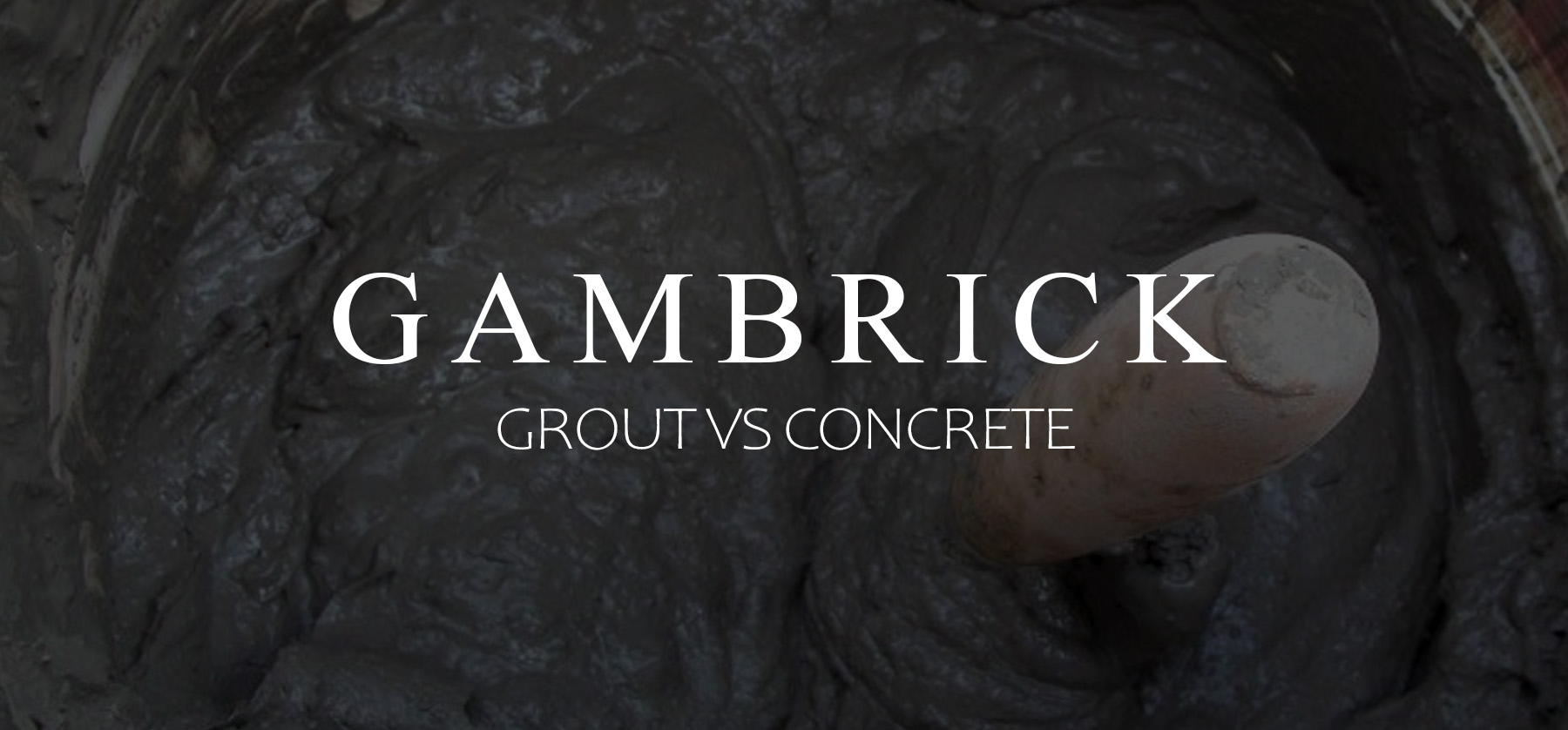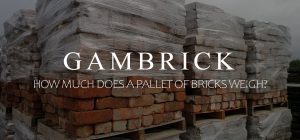
Grout Vs Concrete
Grout and concrete are both cement based powders made up of various ingredients. When mixed with water, the cement chemically reacts to become a paste that later hardens. This is called curing. As curing takes place, both products grow strong and durable. They’re both used in a wide variety of projects ranging from tile, stone, brick, countertops, cast products and foundations. But although they have some similarities, there are also some huge difference. When comparing grout vs concrete for your next project, it’s important to understand what you need the material to do. Concrete has a higher compressive strength which makes it ideal for foundations, but grout is better at filling in gaps and binding objects like brick and stone together.
Concrete and grout can both be used as a type of mortar, which bonds masonry objects together. However, grout is the better bonding agent while concrete is better as a foundation or slab material.
You’ve likely heard the terms grout and concrete before, but probably don’t know everything there is to know about them. Both grout and concrete start out as a cement based product, but concrete has stone. This makes concrete much stronger than grout, but also limits where you can use it.
You can’t use concrete in tight gaps because the stone gets in the way, but grout works great when laid thin. Grout is stickier and better at binding materials together, but concrete is more durable and stronger.
The grout vs concrete debate will never end in the construction industry because each product has it’s own strengths and weaknesses, pros and cons. Which one is best for your next project?
Understanding Grout & Concrete
Grout and concrete both start out in powder form. You can buy them pre-mixed in bags at any home improvement store or make them yourself out of raw ingredients. When mixed with water they become a semi-solid/liquid-like substances that can be poured in place or applied with hand tools. They then dry, which is called curing, to become hard and strong.
When in wet form, grout has the consistency of really wet clay. You can slosh it around with a grout float and push it into small cracks. Concrete is much grittier because of all the sand and stone in it’s mixture. Even though it’s wet, lots of the concrete are still solid which gives it the feel of thick oatmeal.
Grout and concrete are both made by combining various minerals and compounds together like Cement, Sand, Stone, Lime, etc. These ingredients make them strong and adhesive. Cement is the active ingredient that reacts with water to form a paste and harden. The other compounds alter the mixes properties.
When most people think of grout they picture the stuff in between their tiles, and they’re correct, that stuff is called grout, but it’s also used to bind together large brick and stone. Grout is a fantastic binding agent.
Concrete also comes in many forms and has lots of uses. There are a wide variety of mixes available in bagged form or you can make your own. Some are great for setting a post, like Quikrete Fast Drying Mix, while others are better for cast products like countertops.
Once grout and concrete harden, it’s permanent. There’s no way to undo the transformation. For this reason working with them is time sensitive.
What Is Grout?
It’s easy to mistake grout for mortar because they’re so similar. But there are some big differences between the two. Mortar is a general term for the material used to hold brick, stone, and other masonry materials together. This includes some types of grout. The basic mortar mix typically consists of cement, fine sand, and lime. Grout is a type of mortar that’s made without adding the lime.
Lime is added to mortar mixtures to increase durability and pliability. It’s easy to work grout into small gaps and cracks because it’s thinner. It’s a better gap filler and sealer than mortar but not as good of a bonding agent. Grout is commonly used to fill in gaps between tile or in heavy construction for connecting precast concrete sections.
Grout is still considered a type of mortar. But where traditional mortar is made from fine sand, water, cement, and lime, grout only has fine sand, water, and cement. Lime adds durability to the mix which makes grout less durable than other mortar mixes.
But because grout doesn’t have lime, it’s thinner and more viscous than other mortars. It’s one of the few building materials that can form a watertight seal once cured. Grout can easily fill in gaps between tiles and seal them which makes it ideal for wet areas like bathrooms and kitchens.
Grout is sold in powder or pre-mixed form and in a wide variety of colors. Colors are achieved by adding powdered dye to the mix which does effect the grout’s performance.
There are several varieties of grout that are used for different applications.
Types of Grout
Just like concrete, grout comes in a a variety of mixtures designed for different applications. Epoxy grout is used more when the tiles may be exposed to acid or oils.
When the grout is used in bigger construction projects, builders may use a fine or a coarse grout, determined by the aggregate size used in the mixture. Coarse grouts are typically more economical to use for a big project. Epoxy grout can also be useful here because it tends to be stronger than cement-based grout.
Epoxy grout is the number one choice for binding heavy equipment to the floor because it is strong. It also lasts for a very long time and is impervious to most things, including water. This means that you don’t need to worry about the freezing and thawing of water inside an epoxy grout structure.
- Unsanded grout: Used for grouting tiles with small gaps of less than 1/8”. It’s thinner than sanded grout which makes it easier to work into tight joints. It’s also stickier than sanded grout. However, because there’s no sand it cracks easily and looks a bit unnatural when used to fill wide gaps.
- Sanded Grout: Sanded grout is used for tiling joints between 1/8” and 3/8” thick. It’s grittier than unsanded grout which makes it more crack resistant. It’s inexpensive, forms a strong joint, and is easy to work with. I’d consider sanded the most common grout builders use.
- Quarry Grout: This grout contains coarser sand than other mixtures and is used to fill larger joints up to ½” wide.
- Epoxy Grout: A special grout mixture that contains a resin and hardener. It’s highly resistant to moisture and stains and has high bonding ability. It’s used for wide gaps and for tile susceptible to stains.
What’s The Difference Between Grout And Concrete?
Grout has a higher water content than concrete which makes it great at filling tight gaps. You can also use it to seal and bind concrete slabs together. Being watery allows grout to spread out and fill small crevices. Adjust the water based on how you’re using the grout.
Just like concrete, grout is sold in bags as a powder which activates and hardens when mixed with water. But it also comes in pre-mixed buckets and tubes that are great for smaller jobs. Concrete doesn’t offer this as an option.
Grout comes pre-mixed in a wide variety of colors which makes it’s color consistent and easy to match. You can also add your own pigment to make custom colors. Concrete isn’t sold with pre-mixed colors. The only option for colored concrete is to add the pigment yourself. This makes consistent coloring harder to achieve and even harder to match.
Grout is typically used to fill gaps between tiles. This is a job too small for other types of cement-based compounds like concrete. It can also be used to bind two slabs together because it’s such a great sealant. This is also a job concrete isn’t great at.
Grout is also used in large scale construction projects as an adhesive, whereas concrete is typically used as a structural material.
Grout is less porous than concrete which makes it great at sealing out water. This is a huge advantage when using it in wet areas like a bathroom or kitchen.
What Is Concrete?
Concrete is a fantastic building material that’s been used all over the world for centuries. Almost every residential home, building or large scale structure uses concrete somewhere it’s construction. This is because concrete is strong, durable and resistant to the elements. Like grout, it’s a cement based mixture that hardens when mixed with water. But unlike grout, concrete also has coarse aggregate sand and stone. This makes it much grittier and porous which means it absorbs water and is a pore sealant.
Just like grout, concrete starts as a dry powder, but when mixed with water the cement activates and becomes hard during a process called curing. This can take 28 days to complete. During the curing process,concrete get progressively stronger each day. When a bag of concrete says it’s strength is 3500 PSI, it means 3500 PSI after 28 days of curing. Not when freshly poured.
Like grout, concrete can be bought in pre-mixed bags. Companies like Quikrete sell bagged concrete in a variety of strengths with all sorts of special properties like fast setting or crack resistance. You can also get concrete delivered in large amounts by a truck or mix it yourself on site.
Concrete is used in a wide variety of construction projects of all sizes. Building foundations, sidewalks, driveways and roads or smaller jobs like countertops are all achieved using concrete. It’s a much more versatile material than grout.
Concrete can be formed into almost any shape using molds called forms. It’s typically used along with metal reinforcement like rebar or wire mesh which add durability and strength to the structure.
Like grout, concrete can be colored by adding pigment. But unlike grout, it doesn’t come pre-mixed in colors. You have to do the coloring yourself. This makes consistency and color matching a hard job.
What Does Concrete Do Vs Grout
Concrete has a higher compressive strength than grout which is why it’s used to build foundations. This means it can support a lot of weight without cracking. And by including steel rebar, it can also span large distances. This is how most bridges and buildings are built. Without rebar, concrete beams would easily crack even under their own weight.
Even huge structures like damns are built out of concrete. You couldn’t build the Hoover damn with lots of grout because it wouldn’t be strong enough to support the weight.
Concrete is an incredibly versatile building material. You can shovel small batches at a time to set fence posts or pour lots of it into a mold to build foundations. When concrete dries, it will keep the form of whatever it was poured into.
As concrete dries you can shape and smooth it. This is how concrete statues are made. This isn’t something you can do with grout. Concrete is much better at keeping it’s form without cracking.
Because concrete has so much sand and stone, it’s porous and absorbs moisture. Although it’s weather resistant and can even be used under water. Grout doesn’t do this which is why it’s such a great sealant. You couldn’t seal tiles with concrete. In fact grout is used along with concrete slabs to seal the gaps and bind slabs together.
Concrete is much heavier than grout because of all the sand and stone. This makes it a great footing material. Grout is much lighter by volume.
Types of Concrete
Concrete comes in a variety of dry mixes that have different strengths and properties. When you look at a bag of Quikrete that says 3500, the number is referring to it’s strength after 28 days of curing. In this case it’s 3500 PSI. You can adjust the PSI of concrete by adding more stone or using additives.
Concrete is also sold with special properties like fast setting, extra strength or crack resistance. These properties are achieved by using additives or adjusting the ingredients.
For smaller household DIY projects, bags of pre-mixed concrete like Quikrete are ideal. I use the fast setting bag for setting fence posts and the crack resistant one for making concrete countertops.
For larger projects like pouring a foundation or sidewalk, you can order concrete from a supplier. It will be delivered to your jobsite by a barrel truck. This is called ready made concrete. Tell the dealer what type of concrete you need and they’ll mix it for you. Additives like hardeners or colors can be added to the mix on site or by the dealer. Most masons like to add their own.
Lastly, you can mix your own concrete on site out of raw ingredients. 1 Part sand, 1 part Portland cement, 1 ½ parts gravel, and ½ part water is the basic mix. Portland cement is the most commonly used cement for making both concrete and grout. Mixing your own concrete gives you complete control over the mix and all of it’s ingredients. But it’s hard work, if you do it I recommend renting a portable cement mixer.
Both grout and concrete contain cement as the active ingredient which is caustic. Avoid getting it on your skin, in your eyes or breathing the dust. Where safety equipment when dealing with it.
Concrete Additives Vs Grout
There lots of additives you can put in your concrete when it’s either dry or wet.
Calcium chloride added to your concrete makes it set faster. This can be a big help when setting fence posts because you can often install panels the same day.
The opposite of this is a retarding admixture which delays concrete’s set time. This can help in hot weather because concrete will sweat and set too quickly if you’re not careful. To stop this from happening, masons use additives along with plastic sheeting to keep the concrete damp.
Some masons substitute 15-30% of the cement in their mix for fly ash, a byproduct of coal plants. This decreases heat build up inside the concrete as it cures which makes it easier to work with and finish.
Air entraining agents are added to concrete to help with freezing temperatures and deicing salts. These additives trap tiny air bubbles inside the concrete which creates room for water to expand when it freezes. Without them, the concrete can freeze and spall.
Water-reducing additives decreases the amount of water needed to activate cement by 5 to 30%. This can help if you want a really dry mix.
Using integrated fibers create Ultra-High Performance Concrete (UHPC). UHPC fibers are made from stainless steel, fiberglass, basalt, or steel and are typically added into the concrete while it’s being wet mixed. They can dramatically increase the strength of concrete when it’s fully cured.
Color is another very popular additives for both concrete and grout. Grout has the concrete added at the factory which makes consistency and color matching better. However, masons typically add color either into the wet mix or onto a slab as it’s curing. This makes consistency and color matching harder but gives you more options.
Comparing Grout vs. Concrete
Both grout and concrete typically use sand in their mixture, although there is also un-sanded grout for use in very fine cracks. But grout tends to use a much finer sand than concrete. Concrete sand is course and can even contain small pebbles which gives it a grittier texture. And concrete also contains lots of stone.
Because grout uses finer ingredients than concrete, it’s thinner and more spreadable. This makes it easier to work into small cracks and crevices. It’s also less porous which makes it a great water resistant sealant. Whereas wet concrete has the feel of thick oatmeal.
- Concrete is typically used for structural applications like slabs, walls, foundations and cast products like statues.
- Grout is used more like an adhesive to secure tiles, bricks, stone or concrete slabs. It’s also used as a sealant for in between tiles.
Both materials are very strong, can withstand wear and tear, and resist cracking. But they each have their uses on a construction project and are not interchangeable. You wouldn’t pour a slab driveway with grout, that’s a job for concrete. And you wouldn’t install stone or grout tiles with concrete. That’s a job for grout. While they’re very similar, their small differences greatly change the way they’re best used.
The strength of these two materials varies depending on the ingredients and additives used. For example, grout made with epoxy resin instead of cement will be stronger than an average concrete mix. But you can use these same additives in concrete which will make it stronger than grout. But in general, the average concrete mix is much stronger than the average grout mix.
Other Cement Based Mixtures
There are other cement based mixtures often confused with concrete and grout. Although the terms are commonly interchanged, the actual materials should never be substituted for one another. For example, grout is sometimes called mortar, but they’re actually different products. So if a job calls for mortar, use mortar, not grout.
Cement is made from limestone, clay, silica, and shells. It’s commonly referred to as Portland cement because it was first made off the coast of England on an island named Portland. It can be used all by itself as a binding agent or to parge coat a masonry wall. But it gets much stronger when mixed with an aggregate like gravel or sand.
Cement is the active ingredient in all cement based mixtures like grout and concrete. When mixed with water, cement becomes a paste that later hardens becoming strong and durable. Adding additional ingredients to cement changes it into a different substances. For example, adding stone and coarse sand to cement makes it concrete. This is why the terms for cement based products get confused so often.
Concrete, grout, mortar and stucco all start off as cement.
Cement is also the primary ingredient of mortar, a substance very similar to and often confused with grout. If you take the basic grout mix and add lime, you get mortar. A more durable form of grout. Like grout, it’s used to bind brick, stone, and other masonry materials. But it’s not as good a sealant, which is why we don’t use mortar to seal shower or bathroom tile, we use grout.
Stucco is made from cement mixed with sand, lime, and water. It’s spread as a thin coating on a house’s exterior. This is called a parge coat. It’s stronger than cement alone because of the additional ingredients.
How Is Grout & Concrete Strength Measured?
The strength of concrete, grout, and other cement-based products are measured in a few ways. These include compressive, tensile and flexural strength. Each type measures how well a substance holds up under different forms of pressure.
Compressive Strength
Compressive strength is the ability to withstand pressure that decreases the size of the substance. In other words, how much weight you can place on something before it breaks. This is a very important strength characteristic for things like concrete, because structures are built on top of it. Engineers need to know exactly how much weight a concrete foundation can hold before cracking. If they get this measurement wrong a foundation could fail under the load placed atop it.
Compressive strength is measured in pounds per square inch or psi.When you look at a bag of Quikrete 3500 concrete, the 3500 refers to its PSI. Keep in mind that psi values are calculated at 28 days of full curing, not when first hardened.
PSI values are determined in a lab by a compression test machine. A cylinder or block of a substance, for example concrete, is placed under a heavy load until it breaks. How much load it can carry before breaking is calculated by the machine to determine its psi.
The standard mix of concrete has higher compressive strength than grout.
Tensile Strength
Tensile strength is the ability to resist cracking or breaking under stretching or pulling forces.Masonry products like grout and concrete don’t have much tensile strength because they’re rigid.
To fix this, rebar and other forms of reinforcement can be added to concrete to increase its tensile strength. This is how concrete beams are made. Without rebar, concrete beams would crack under their own weight.
In terms of grout, sand and other additives can be added to increase it’s tensile strength a little bit. But grout isn’t typically used in applications that need much tensile strength so it’s not generally an issue.
Flexural Strength
Flexural strength is the ability to resist bending under stress. This is very similar to tensile strength. Most masonry products like concrete and grout don’t have much flexural strength because they’re so rigid. However, additives can be included in the mix to increase flexural strength a little bit. For example, Quikrete makes a few products with additives that increase its crack resistance by making it a little more flexible.
Rebar and other forms of reinforcement can be added to concrete to compensate for a lack of flexibility. No additive or reinforcement material is going to make masonry products bend, but their naturally solid state can be adjusted for with smart design.
Factors That Influence Grout & Concrete Strength
If you’re working with grout or concrete, it’s strength will be affected by common factors that you can influence either with smart design or product preparation.
For example, adding too much water is a great way to weaken your concrete or grout. Always make sure to carefully measure water levels. Watery product is easier to spread, but it’ll be weak and prone to cracks.
Mixing time influences the product’s strength. Water can evaporate as the product sits so mix your concrete and grout right before you use it. Don’t let it sit and dry out.
Strength can be gained with proper curing. This is especially true for concrete. Keeping your concrete and grout wet for longer periods of time will enhance its strength. This is very important when you first install the product and why many masons will cover fresh concrete with plastic. Especially if it’s hot and sunny out. Don’t let grout or concrete dry too fast.
In general, cement-based products strengthen over time. This can happen for years after the first 28 days of curing is over.
Reinforcement is a very big factor for concrete because it’s often used structurally. If concrete fails it can be a major disaster. Additives, wire mesh and rebar can all be used to increase concrete’s strength.
Grout can crack if its not strong enough. This isn’t as big a deal as a concrete bridge failing, but it can still be really bad. Cracks in your shower grout can lead to water damage and mold. It can also lead to cracks in brick or stone work. So take grout strength seriously too. Especially in wet areas or where the grout is used as a binding agent.
Is Too Much Strength Bad?
Oddly enough, when it comes to grout and concrete, too much strength can actually be a bad thing. This typically happens when two products are used together, such as grout and brick or stone.
In certain situations, it can be better to use a weaker bonding material that matches the strength of the other materials. An example of this is restoration work. When we restore old historical brick buildings, we use a much weaker grout than we would with new brick. This is to preserve the older bricks that may be brittle. A super strong grout can be too harsh for older bricks which can lead to breaks in the weaker areas.
Building guidelines may specify a maximum strength for grout and concrete in a variety of settings. This can be set by an engineer or architect. For example, the Masonry Standards Joint Committee dictates the minimum and maximum standards for the compressive strength of grout and concrete depending on the other materials being used. In other words, you may have to use a different concrete or grout strength based on the stone or brick your using it on.
Grout Vs Concrete Strength
Grout and concrete are very close in overall strength. They both have good compressive strength with low tensile and flexural strength. What this means is that both grout and concrete can support a good amount of weight, but crack when under tensile or flexural loads. To compensate for this, additives and reinforcements like rebar and wire mesh are used. There are also chemical and psychical additives like micro rebar that can increase strength.
Generally speaking, most reinforcement methods are used in concrete. Grout is typically used as either a bonding agent to set brick and stone or to fill gaps in tile. Builders don’t use grout in structural applications much. However many structures are built entirely out of concrete.
The relative strength of grout and concrete also depends on the mixture you’re comparing. There are grout mixes using additives with much higher compressive strength than concrete. But those additives can also be added to concrete. Overall, the average concrete mix is much stronger than the average grout mix.
When comparing grout vs concrete strength, its important to keep in context how you’ll be using the material. Most people use grout to fill in the gaps between kitchen and bath tiles. For this application, grout is much stronger than concrete. But if you’re pouring a sidewalk, I’d use concrete.
How Strong Is Grout?
The average grout mix has a compressive strength of about 2,000– 5,000 psi. Just like concrete, this can be adjusted with additives.
Masons can adjust the strength of the grout to match the strength of the other materials. This comes in handy when working with brittle materials like old brick.
The strongest type of grout is epoxy grout. It’s a specialty grout that’s mixed with resin and a hardener instead of cement. It can reach strengths of 12,000 psi and is used to bind heavy objects.
Traditional cement grout has a tensile strength of about 870 psi or about 20-40% of its compressive strength. This isn’t much which is why grout breaks so easily under tensile loads.
How Strong Is Concrete?
The strength of concrete depends on its ingredients,their sizes and ratios. More stone and bigger stone means a heavier, stronger concrete with a higher psi. This mix is great for foundation work and typically has a psi of around 5000. Less or smaller stones makes a concrete that’s around 3000 psi which is better for things like countertops or statues.
- Concrete slabs on the ground usually have a compressive strength of 3,500 to 4,000 psi.
- I use 4000 for driveways and 3500 for sidewalks.
- Concrete walls and columns typically have 3500 psi.
- Cast products like countertops can use 3000 psi concrete.
- Large scale commercial projects like buildings, bridges and damns can use concrete over 5000 psi.
Concrete used in colder climates typically require a higher compressive strength to withstand the freeze and thaw cycle.
In most construction settings, the maximum compressive strength you’ll find is about 7,500 psi. But in laboratory settings, concrete strength can be made over 15,000.
The tensile and flexural strength of concrete tend to be around 10-15% of its compressive strength. This is very low which is why concrete breaks so easily when not supported. Concrete structures are reinforced with materials such as steel rebar, wire mesh and additives to compensate for the issue. Without reinforcing techniques, most large scale construction that relies on concrete would be impossible.
Ultra High Performance Concrete, or UHPC, is much stronger than standard concrete or grout. It can have compressive strength of between 20,000-50,000 psi. Its tensile and flexural strengths are also higher, but still very low in comparison.
Other Building Materials Compared To Grout & Concrete
When considering the strength of grout and concrete, it’s important to know how strong other materials are too. This is very helpful when you’re using materials together.
The following chart lists the average compressive and tensile strength of some common building materials you’d use with grout and concrete:
| Material | Compression Strength | Tensile Strength |
| Hard Bricks | 12,000 psi | 400 psi |
| Soft Bricks | 1,000 psi | 40 psi |
| Old Brickwork | 1,000 psi | 50 psi |
| New Brickwork | 2,000 psi | 300 psi |
| Granite | 19,000 psi | 700 psi |
| Limestone | 9,000 psi | 300 psi |
| Sandstone | 9,000 psi | 300 psi |
| Slate | 14,000 psi | 500 psi |
| Gravel | 20,000 psi | 800 psi |
Grout vs Concrete Strength Comparison
Standard grout and concrete mixes are about equal in compressive strength. But it depends on the mix used and it’s application. Additives can be used to increase both grout and concrete’s strengths when needed.
Even though technically, concrete and grout have very similar strength levels, concrete is considered stronger than grout. This is mainly due to how it’s used. Builders use concrete to build all sorts of structures like buildings, brides and damns. You wouldn’t use grout to build a home’s foundation. But grout is still very strong and great as a bonding agent or crack filler. It’s also a fantastic water sealant which is why we use it in wet areas like bathrooms and kitchens.
Then there’s the new Ultra-High Performance Concrete that can be as much as ten times stronger than either traditional concrete or grout. Nothing even comes close.
When comparing grout vs concrete in terms of strength, think about how you’ll be using it to find out which material is best for your project. Then alter the materials strength as needed.
Applications
Both grout and concrete are cement based products that are used in all sort of projects. But although they’re very similar materials, in practice they’re very different.
- Grout is typically used for filling in gaps or binding objects like brick or stone together. It’s typically more vicious than concrete which makes it easy to squeeze into gaps. It’s also sticky so using grout to bind objects is easy.
- Concrete is a very versatile and cost-effective construction material. Builders use it for large scale projects like foundations and driveways or for smaller things like setting a fence post or making countertops.
Measuring Strength
There’s a lot to consider when it comes to the strength of grout and concrete.
- Compressive strength measures the ability to withstand pressure without cracking.
- Tensile strength measures the ability to withstand breaking while under tension of being pulled apart.
- Flexural strength measures the strength of a material to resist breaking when bent.
Both concrete and grout have high levels of compressive strength but very low levels of tensile and flexural.
Strength levels are measured in psi or pounds per square inch.
Summary: Grout Vs Concrete. What’s The Difference? Which Is Better? Stronger?
Grout and concrete are both cement based powders commonly used in construction. When mixed with water, the cement chemically reacts to become a paste that later hardens. This is called curing. As curing takes place, both products grow strong and durable. They’re both used in a wide variety of projects ranging from tile, stone, brick, countertops, cast products and foundations. But although they have some similarities, there are also some huge difference. When considering grout vs concrete for your next project, it’s important to understand what you need the product to do. Concrete has a higher compressive strength which makes it ideal for foundations, but grout is better at filling in gaps and binding objects together.
You’ve likely heard the terms grout and concrete before, but probably don’t know everything there is to know about them. Both grout and concrete start out as a cement based product, but concrete has stone. This makes concrete much stronger than grout, but also limits where you can use it. You can’t use concrete in tight gaps because the stone gets in the way, but grout works great when laid thin. Grout is stickier and better at binding materials together, but concrete is more durable.
The grout vs concrete debate will never end in the construction industry because each product has it’s own strengths and weaknesses, pros and cons. What you need to decide is which is best for your next project.
If you have any questions or comments about grout or concrete Email any time.

John Mazzuca | About | More Posts |
Custom Home Builder
John Mazzuca is a custom home designer and builder at Gambrick with over 25 years experience in the construction industry. John has designed, built and/or remodeled hundreds of homes, small buildings, and commercial projects. He writes about business, real estate, home building, and household electronics. His work has been featured in Fox Business, Better Homes & Garden, House Beautiful, and more.




















